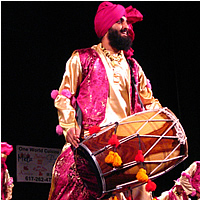The signature scent of exotic food filled the air…pakoras, samosas, and aloo tikki scent the foyer of the theater, while mango and lychee juice makes me realize I’m insanely thirsty. I am surrounded by colorful headscarves and beautiful women, convivial chatter and solace from the rain outside.
This event marks the fifth annual Boston Bhangra Competition.
Bhangra is a form of traditional folk music from the Punjab region of India. The word itself has evolved to refer to modern Asian pop music. The twelve competing teams perform routines set to this music, combining traditional dance moves and costumes with sounds and movements from modern culture.
But this is much more than just a dance competition. Boston Bhangra is a nonprofit organization that gives back to the community, mainly by organizing youth mentor programs that teach bhangra dancing to those that want to learn it.
Rohit Bhambi, the current treasurer and acting CEO, explains the importance of mentoring young adults with this shared heritage. “Dancing is one aspect. Really, it’s about cultural building for children. We don’t want them to forget who they are. It’s hard growing up in America; one big initiative is to help them know about [their roots] and then they get excited about their culture.”
One thing was certain: everyone in the room was definitely excited about the culture being celebrated.
I have no sub-continental roots to speak of, but I was ecstatic just from watching everyone else around me. The people who have gathered here feel strongly about the relevance and importance of celebrating their heritage. The biggest indicator of this is a sold out 2008 event, which follows the same sellout scenario that has been the case every year for the last five years.
 Some of the teams were in the theater before curtain call, sparkling with gold coins and bracelets. Red, yellow, green, and fuchsia satins glisten alongside tufted head fans. An older couple sat next to me, and explained that reds and yellows are the predominant colors here as well as in India, and that the addition of headpieces on the men is a result of the cultural influences of India.
Some of the teams were in the theater before curtain call, sparkling with gold coins and bracelets. Red, yellow, green, and fuchsia satins glisten alongside tufted head fans. An older couple sat next to me, and explained that reds and yellows are the predominant colors here as well as in India, and that the addition of headpieces on the men is a result of the cultural influences of India.
I love that I have no prior concept of Bhangra, but was able to sponge it up as I sat, listened and watched. The competing teams came from all over North America: Florida, New Jersey, Washington, D.C., California, Virginia and Canada. The judges of the competition scored based on originality, expression, energy, complexity, and transitions, among other things.
As the lights dimmed and the stragglers found their seats, supporters of the local Boston University and MIT teams shouted chants, while the girl behind me screams as loud as humanly possible, unknowingly right into my ear. Mu curiosity is seriously piqued, simply from the energy in the room.
Each group put on a spectacular routine. Dancers combined amazing feats of coordination with big smiles, drumming, props, acrobatic stunts, great music, and intense spirit. Team members sang along to their routine music as they twirled and jumped with fervor.
“Oh dude that was so awesome,” said a male college student behind me, who verbally wowed all of the moves and stunts that he found impressive. A group of three guys in the aisle to my left danced along to their favorite team during its performance. The audience roared every time a team came on and off the stage.
This year’s first place winner was Bhangra Empire, followed by VCU, then the Sher Foundation. Each team won $2,500, $1,000, and $500 respectively. According to Bhambi, “Bhangra Empire is probably one of the best co-ed teams in North America right now. They combine energy, enthusiasm, formations, and originality in a unique way that helps them stick out.”
Bhambi was extremely pleased with the turnout and the show itself. “The teams had fun, the audience enjoyed the show, and we were very satisfied with the whole weekend. We still have a bunch of admin work to do, but overall, it was a huge success!”




